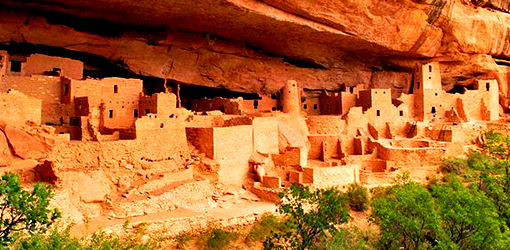Imagination as Social Practice
Posted on December 15, 2012 | posted by:
“The imagination has become an organized field of social practices, a form of work (in the sense of both labor and culturally organized practice,) a form of work (in the sense of both labor and culturally organized practice,) and a form of negotiation between sites of agency (individuals) and globally defined field of possibility.” (Appadurai, Disjuncture and Difference in the Global Cultural Economy)
A few summers ago, I took a one-week art history course on the Pueblo Anasazi Indians. Around fifty students and I signed up to take the class and camp out in Mesa Verde, Colorado, a place where the Anasazi Indians once called their home. The Anasazi first settled in Mesa Verde in around A.D. 550, inhabiting the area for over 700 years. The tribe built a small foundation in Mesa Verde, which eventually blossomed into a full-fledged city. Then suddenly, they disappeared. Although we may never know for sure why the Anasazi migrated from their long-established home, what they left behind gives a glimpse into the possible role collective imagination may have played.
__
As Appadurai mentions in the Disjuncture and Difference in the Global Cultural Economy, “one man’s imagined community is another man’s political prison.” When I was camping out on the beautifully green, lush terrain, Mesa Verde seemed like a voguish utopia. However, this place must have been an inexorable political prison of sorts for the Anasazi to leave behind everything the culture had established over the past seven-hundred years. More importantly, they would have also must have each imagined a different, though better life; an imagination which drove them to move on and abandon their environment. “The imagination is now central to all forms of agency, is itself a social fact, and is the key component of the new global order.”
__
There is much speculation on why the Anasazi Indians left Mesa Verde. The once small community that had inhabited a few small, self-constucted dwellings had developed into manipulating the entire landscape to establish a prosperous neighborhood. Cave dwellings resembled modern tiny apartment complexes, and provided a sophisticated shelter from the Colorado elements. This seemingly flourishing environment would have cultivated a probable enduring civilization dwelling. So why then, did the Anasazi suddenly migrate?
__
Appadurai speaks of five dimensions of “global cultural flows,” ethnoscapes, mediascapes, technoscapes, financescapes, and ideoscapes. Although the efficacy of these dimensions is aimed to represent the complexity of the current global economy, one of them in particular illustrates a conceptual proposition for why the Anasazi may have abandoned Mesa Verde in A.D. 1300. Appadurai defines mediascapes as follows:
“whether produced by private or state interests, tend to be image-centered, narrative based accounts of strips of reality, and what they offer to those who experience and transform them in a series of elements (such as characters, plots, and textual forms) out of which text can be formed of imagined lived, their own as well as those living in other places. These scripts can also be sets of metaphors by which people live (Lakoff and Johnson 1980) as they help to constitute narratives of the Other and protonarractives of possible lives, fantasies that could become prolegomena to the desire for acquisition and movement.”
__
The Anasazi did leave behind many pieces of history from their lost civilization, including hundreds of depictions on rocks surrounding where they once lived. These are the only scripts left that express the trials and tribulations of the Anasazi civilization. Over eight-hundred years after they abandoned Mesa Verde, the stylized markings remain. These markings constitute the clearest, currently-accessible narrative of the Anasazi culture. The markings also illustrate the collective imagination of Anasazi culture, and social practices that illuminate their values, experiences, and desperations.
